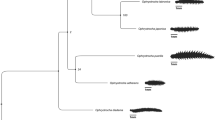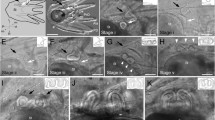Abstract
Data on embryonic and larval development times (D) of Calanus species are analysed using Bělehrádek's temperature (T) function, D = a (T − α)b, with b = − 2.05 as in previous studies. Among these species, α for embryonic duration varies directly with temperatures in their geographical ranges and a is related to egg diameter. Using α and b from embryonic durations, the fitted values of a for older stages are related to body sizes. Roughly estimated nucleus numbers in single adult females of C. finmarchicus, glacialis and hyperboreus were similar at 72 000, 85 000, and 96 000 respectively. Genome sizes (2C) of adult females are ca. 13 pg DNA in C. finmarchicus and pacificus, ca. 17 pg in C. sinicus, ca. 21 pg in C. helgolandicus and marshallae, and ca. 25 pg in C. glacialis and hyperboreus. These correspond roughly to body sizes and temperature-corrected development rates, quite precisely so in the sibling pair C. finmarchicus and C. glacialis, suggesting that, given similar nucleus numbers, there is nucleotypic control of whole-organism characteristics.
Similar content being viewed by others
References
Cavalier-Smith, T. (ed.), 1985. The evolution of genome size. John Wiley & Sons, New York
Corkett, C. F., 1972. Development rate of copepod eggs of the genus Calanus. J. exp. mar. Biol. Ecol. 10: 171–175.
Corkett, C. J. & I. A. McLaren, 1969. Relationships between development rate of eggs and older stages of copepods. J. mar. biol. Ass. UK 50: 161–168.
Corkett, C. J., I. A. McLaren & J. -M. Sevigny, 1986. The rearing of the marine calanoid copepods Calanus finmarchicus (Gunnerus), C. glacialis Jaschnov and C. hyperboreus Krøyer with comment on the equiproportional rule. Syllogeus (Nat. Mus. Can.) 58: 539–546.
Eriksson, S., 1973. The biology of the marine planktonic Copepoda on the West coast of Sweden. Zoon 1: 37–68.
Frost, D. W., 1974. Calanus marshallae, a new species of calanoid copepod closely allied to the sibling species C. finmarchicus and C. glacialis. Mar. Biol. 26: 77–99.
Grainger, E. H., 1963. Copepods of the genus Calanus as indicators of eastern Canadian waters. In M. J. Dunbar (ed.), Marine Distributions. Univ. Toronto Press, Toronto: 68–94.
Harris, J. R., 1983. The development and growth of Calanus copepodites. Limnol. Oceanogr. 28: 142–147.
Klein Breteler, W. C. M. & S. R. Gonzalez, 1982. Influence of cultivation and food concentration on body length of calanoid copepods. Mar. Biol. 71: 157–161.
Landry, M. R., 1983. The development of marine calanoid copepods with comment on the isochronal rule. Limnol. Oceanogr. 28: 614–624.
Marshall, S. M. & A. P. Orr, 1952. On the biology of Calanus finmarchicus. VII: Factors affecting egg production. J. mar. biol. Ass. U.K. 30: 527–547.
Matthews, J. B. L., 1967. Calanus finmarchicus S. L. in the North Atlantic. The relationships between Calanus finmarchicus S. Str., C. glacialis and C. helgolandicus. Bull. mar. Ecol. 6: 159–179.
McLaren, I. A., 1966. Predicting development rate of copepod eggs. Biol. Bull. 131: 457–469.
McLaren, I. A., 1986. Is structural growth of Calanus potentially exponential? Limnol. Oceanogr. 31: 1342–1346.
McLaren, I. A., and D. J. Marcogliese, 1983. Similar nucleus numbers among copepods. Can. J. Zool. 61: 721–724.
McLaren, I. A., S. M. Woods & J. R. Shea, Jr., 1966. Polyteny: a source of cryptic speciation among copepods. Science 153: 1641–1642.
Peters, R. H., 1983. The ecological implications of body size. Cambridge University Press, Cambridge, England. 329 pp.
Peterson, W. T., 1986. Development, growth, and survivorship of the copepod Calanus marshallae in the laboratory. Mar. Biol. 29: 61–72.
Rasch, E. M., H. J. Burr & R. W. Rasch, 1971. The DNA content of sperm of Drosophila melanogaster. Chromosoma (Berlin) 33: 1–18.
Robins, J. H., & I. A. McLaren, 1981. Unusual variations in nuclear DNA contents in the marine copepod Pseudocalanus. Can. J. Genet. Cytol. 24: 529–540.
Sevigny, J. -M., and I. A. McLaren, 1988. Protein polymorphisms in six species of the genus Calanus. Hydrobiologia 167/168: 267–274.
Thompson, B. M., 1982. Growth and development of Pseudocalanus elongatus and Calanus sp. in the laboratory. J. mar. biol. Ass. UK 62: 359–372.
Uye, S., 1988. Temperature dependent development of Calanus sinicus (Copepoda: Calanoida) in the laboratory. Hydrobiologia 167/168: 285–293.
Woods, S. M., 1969. Polyteny and size variations of the copepod Pseudocalanus from two semi-landlocked fiords on Baffin Island. J. Fish. Res. Bd Can. 26: 543–556.
Woodhouse, C., 1971. A study of the ecological relationships and taxonomic status of two species of the genus Calanus (Crustacea: Copepoda). Ph.D. thesis, University of British Columbia, Vancouver, 145 pp.
Author information
Authors and Affiliations
Rights and permissions
About this article
Cite this article
McLaren, I.A., Sevigny, J.M. & Corkett, C.J. Body sizes, development rates, and genome sizes among Calanus species. Hydrobiologia 167, 275–284 (1988). https://doi.org/10.1007/BF00026315
Issue Date:
DOI: https://doi.org/10.1007/BF00026315




